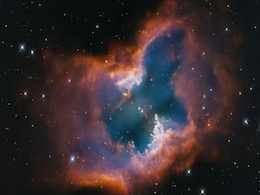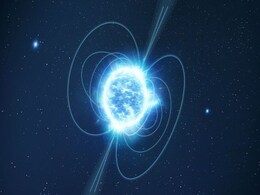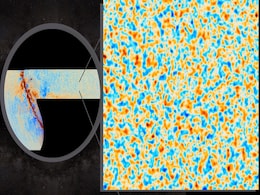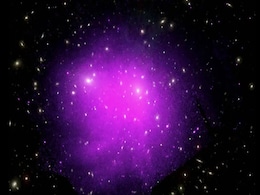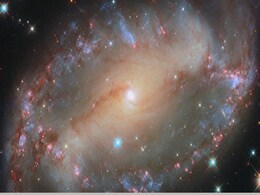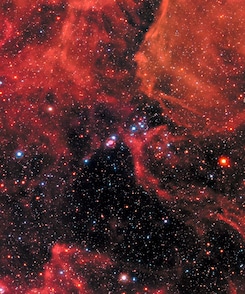Hubble Telescope
- All
- News
- Web Stories
-

Hubble Captures Mars, Cosmic Nebulae, and Distant Galaxies in Spectacular 35th Anniversary Photos
- Saturday April 26, 2025
- Written by Gadgets 360 Staff
To celebrate 35 years in orbit, the Hubble Space Telescope has released breathtaking new images of Mars, a planetary nebula, and a distant spiral galaxy. Since its 1990 launch, Hubble has captured nearly 1.7 million observations and continues to awe scientists and stargazers alike with vivid cosmic scenes that reveal the ever-changing beauty of our...
-
 www.gadgets360.com
www.gadgets360.com
-

Neighbouring Planets To Faraway Galaxies, NASA Shares Stunning Pics To Celebrate Hubble Telescope's 35th Anniversary
- Thursday April 24, 2025
- Science | Edited by Bhavya Sukheja
To mark the 35th anniversary of the Hubble Space Telescope, the US space agency NASA released new high-definition photos taken with the technological marvel.
-
 www.ndtv.com
www.ndtv.com
-

NASA Hubble Space Telescope Helps Confirm the First Solitary Black Hole
- Friday April 18, 2025
- Written by Gadgets 360 Staff
In the Sagittarius constellation, a lone and first-ever solitary black hole has been discovered by a team of scientists. Although the discovery began in the year 2011, the observations have confirmed it recently. The size of this black hole is as massive as seven times of the sun. Despite the conflicts and differences of observations by another tea...
-
 www.gadgets360.com
www.gadgets360.com
-

NASA’s Hubble Space Telescope Shares Detailed Mosaic of the Sombrero Galaxy
- Friday April 18, 2025
- Written by Gadgets 360 Staff
NASA’s Hubble reveals a detailed view of the Galactic favourite, the Sombrero Galaxy, telling about the rare shape of the galaxy. The Sombrero Galaxy is found to have metal-rich stars in its outer region. This research has a future scope of getting deeper insights into its formation by using the advanced imaging technique of Hubble.
-
 www.gadgets360.com
www.gadgets360.com
-

NASA’s Hubble Space Telescope Tracks a Neutron Star With Mysterious Origin
- Wednesday April 16, 2025
- Written by Gadgets 360 Staff
NASA’s Hubble Space Telescope spotted a rogue magnetar, dubbed SGR 0501+4516, traversing our galaxy for a significantly long time. As per claims by scientists, it was first discovered in the year 2008 by NASA's Swift Observatory as intense flashes of gamma rays in the outer area of the Milky Way
-
 www.gadgets360.com
www.gadgets360.com
-

Atacama Telescope Reveals Most Detailed Cosmic Microwave Background Yet
- Thursday March 20, 2025
- Written by Gadgets 360 Staff
New images from the decommissioned Atacama Cosmology Telescope offer the most detailed view of the cosmic microwave background. The data reveals early cosmic structures, tracks primordial gas movement, and refines estimates of the universe’s total mass. While supporting existing models, it does not resolve the Hubble tension. Researchers are now ...
-
 www.gadgets360.com
www.gadgets360.com
-

Hubble Telescope Captures NGC 4536, a Starburst Galaxy with Intense Star Formation
- Wednesday March 26, 2025
- Written by Gadgets 360 Staff
NASA’s Hubble Space Telescope has captured a striking image of NGC 4536, a starburst galaxy 50 million light-years away in the Virgo constellation. The galaxy’s sweeping spiral arms are filled with young blue star clusters and ionized hydrogen gas, indicating rapid star formation. Astronomers believe its bar-like structure channels gas toward t...
-
 www.gadgets360.com
www.gadgets360.com
-

Smallest Galaxy Ever Found: Andromeda XXXV Defies Cosmic Evolution Models
- Thursday March 13, 2025
- Written by Gadgets 360 Staff
Astronomers have discovered Andromeda XXXV, the smallest and faintest known galaxy, located 3 million light-years away. It challenges existing models of galaxy formation, as similar small galaxies were thought to be destroyed in the early universe. Researchers are studying how it retained conditions for star formation despite harsh cosmic environme...
-
 www.gadgets360.com
www.gadgets360.com
-

Hubble Captures Stunning Tarantula Nebula Image, Revealing Cosmic Dust and Star Formation
- Thursday February 27, 2025
- Written by Gadgets 360 Staff
A new image from the Hubble Space Telescope highlights the Tarantula Nebula’s complex structure, featuring dense cosmic dust clouds and vibrant star-forming regions. This nebula, located 160,000 light-years away, plays a vital role in understanding stellar evolution. The captured details offer insights into how cosmic dust contributes to star and...
-
 www.gadgets360.com
www.gadgets360.com
-

Hubble’s New Image of Tarantula Nebula Showcases Cosmic Dust and Star Formation
- Tuesday February 18, 2025
- Written by Gadgets 360 Staff
NASA/ESA’s Hubble Space Telescope has captured a breathtaking image of the Tarantula Nebula, located 160,000 light-years away in the Large Magellanic Cloud. The image reveals intricate cosmic dust patterns and active star formation, offering valuable insights into the role of interstellar material in stellar evolution. Researchers are using the d...
-
 www.gadgets360.com
www.gadgets360.com
-

Hubble Spots Distant Supernova in Gemini, Enhancing Cosmic Distance Studies
- Tuesday February 4, 2025
- Written by Gadgets 360 Staff
The NASA/ESA Hubble Space Telescope has captured a stunning image of SN 2022aajn, a Type Ia supernova in the constellation Gemini. Located 600 million light-years away, the explosion was first detected in November 2022. Type Ia supernovae serve as essential cosmic distance markers due to their predictable brightness. Hubble’s observations, part o...
-
 www.gadgets360.com
www.gadgets360.com
-

Researchers Spot Unusual, Overmassive Globular Clusters in Ultra-Diffuse Galaxy FCC 224
- Friday January 31, 2025
- Written by Gadgets 360 Staff
A new study has uncovered an unexpected globular cluster system in FCC 224, an ultra-diffuse galaxy located in the Fornax cluster. Using data from the Hubble Space Telescope and the Keck Cosmic Web Imager, researchers found that FCC 224 hosts luminous, overmassive globular clusters with unusual properties. The galaxy’s star clusters exhibit narro...
-
 www.gadgets360.com
www.gadgets360.com
-

Coma Cluster’s Distance Closer Than Predicted, Amplifying Hubble Tension Crisis
- Friday January 24, 2025
- Written by Gadgets 360 Staff
A new study led by Dan Scolnic and Adam Riess reveals that the Coma Cluster is 38 million light-years closer than predicted by standard cosmological models, intensifying the ongoing Hubble tension. This discrepancy, involving measurements of type Ia supernova explosions, challenges the universe's expansion rate as predicted by the Hubble–Lemaîtr...
-
 www.gadgets360.com
www.gadgets360.com
-

New Study Uncovers Discrepancies in Universe’s Expansion Rate, Challenges Cosmology Models
- Wednesday January 22, 2025
- Written by Gadgets 360 Staff
A recent study has revealed inconsistencies in the universe's expansion rate, further challenging established cosmological models. Measurements from the Hubble Space Telescope, James Webb Space Telescope, and the Dark Energy Spectroscopic Instrument (DESI) indicate that the universe is expanding at varying speeds. This discrepancy raises critical q...
-
 www.gadgets360.com
www.gadgets360.com
-

Hubble Telescope Observes Young Stars HOPS 150 and HOPS 153 in Orion Nebula
- Wednesday January 22, 2025
- Written by Gadgets 360 Staff
The Hubble Space Telescope has captured images of two young stars, HOPS 150 and HOPS 153, in the Orion Nebula, which is located about 1,300 light-years from Earth. The binary system HOPS 150 glows in bright golden red, while HOPS 153 emits a colorful jet. These stars are still in their early stages of development, feeding from their surrounding dus...
-
 www.gadgets360.com
www.gadgets360.com
-

Hubble Captures Mars, Cosmic Nebulae, and Distant Galaxies in Spectacular 35th Anniversary Photos
- Saturday April 26, 2025
- Written by Gadgets 360 Staff
To celebrate 35 years in orbit, the Hubble Space Telescope has released breathtaking new images of Mars, a planetary nebula, and a distant spiral galaxy. Since its 1990 launch, Hubble has captured nearly 1.7 million observations and continues to awe scientists and stargazers alike with vivid cosmic scenes that reveal the ever-changing beauty of our...
-
 www.gadgets360.com
www.gadgets360.com
-

Neighbouring Planets To Faraway Galaxies, NASA Shares Stunning Pics To Celebrate Hubble Telescope's 35th Anniversary
- Thursday April 24, 2025
- Science | Edited by Bhavya Sukheja
To mark the 35th anniversary of the Hubble Space Telescope, the US space agency NASA released new high-definition photos taken with the technological marvel.
-
 www.ndtv.com
www.ndtv.com
-

NASA Hubble Space Telescope Helps Confirm the First Solitary Black Hole
- Friday April 18, 2025
- Written by Gadgets 360 Staff
In the Sagittarius constellation, a lone and first-ever solitary black hole has been discovered by a team of scientists. Although the discovery began in the year 2011, the observations have confirmed it recently. The size of this black hole is as massive as seven times of the sun. Despite the conflicts and differences of observations by another tea...
-
 www.gadgets360.com
www.gadgets360.com
-

NASA’s Hubble Space Telescope Shares Detailed Mosaic of the Sombrero Galaxy
- Friday April 18, 2025
- Written by Gadgets 360 Staff
NASA’s Hubble reveals a detailed view of the Galactic favourite, the Sombrero Galaxy, telling about the rare shape of the galaxy. The Sombrero Galaxy is found to have metal-rich stars in its outer region. This research has a future scope of getting deeper insights into its formation by using the advanced imaging technique of Hubble.
-
 www.gadgets360.com
www.gadgets360.com
-

NASA’s Hubble Space Telescope Tracks a Neutron Star With Mysterious Origin
- Wednesday April 16, 2025
- Written by Gadgets 360 Staff
NASA’s Hubble Space Telescope spotted a rogue magnetar, dubbed SGR 0501+4516, traversing our galaxy for a significantly long time. As per claims by scientists, it was first discovered in the year 2008 by NASA's Swift Observatory as intense flashes of gamma rays in the outer area of the Milky Way
-
 www.gadgets360.com
www.gadgets360.com
-

Atacama Telescope Reveals Most Detailed Cosmic Microwave Background Yet
- Thursday March 20, 2025
- Written by Gadgets 360 Staff
New images from the decommissioned Atacama Cosmology Telescope offer the most detailed view of the cosmic microwave background. The data reveals early cosmic structures, tracks primordial gas movement, and refines estimates of the universe’s total mass. While supporting existing models, it does not resolve the Hubble tension. Researchers are now ...
-
 www.gadgets360.com
www.gadgets360.com
-

Hubble Telescope Captures NGC 4536, a Starburst Galaxy with Intense Star Formation
- Wednesday March 26, 2025
- Written by Gadgets 360 Staff
NASA’s Hubble Space Telescope has captured a striking image of NGC 4536, a starburst galaxy 50 million light-years away in the Virgo constellation. The galaxy’s sweeping spiral arms are filled with young blue star clusters and ionized hydrogen gas, indicating rapid star formation. Astronomers believe its bar-like structure channels gas toward t...
-
 www.gadgets360.com
www.gadgets360.com
-

Smallest Galaxy Ever Found: Andromeda XXXV Defies Cosmic Evolution Models
- Thursday March 13, 2025
- Written by Gadgets 360 Staff
Astronomers have discovered Andromeda XXXV, the smallest and faintest known galaxy, located 3 million light-years away. It challenges existing models of galaxy formation, as similar small galaxies were thought to be destroyed in the early universe. Researchers are studying how it retained conditions for star formation despite harsh cosmic environme...
-
 www.gadgets360.com
www.gadgets360.com
-

Hubble Captures Stunning Tarantula Nebula Image, Revealing Cosmic Dust and Star Formation
- Thursday February 27, 2025
- Written by Gadgets 360 Staff
A new image from the Hubble Space Telescope highlights the Tarantula Nebula’s complex structure, featuring dense cosmic dust clouds and vibrant star-forming regions. This nebula, located 160,000 light-years away, plays a vital role in understanding stellar evolution. The captured details offer insights into how cosmic dust contributes to star and...
-
 www.gadgets360.com
www.gadgets360.com
-

Hubble’s New Image of Tarantula Nebula Showcases Cosmic Dust and Star Formation
- Tuesday February 18, 2025
- Written by Gadgets 360 Staff
NASA/ESA’s Hubble Space Telescope has captured a breathtaking image of the Tarantula Nebula, located 160,000 light-years away in the Large Magellanic Cloud. The image reveals intricate cosmic dust patterns and active star formation, offering valuable insights into the role of interstellar material in stellar evolution. Researchers are using the d...
-
 www.gadgets360.com
www.gadgets360.com
-

Hubble Spots Distant Supernova in Gemini, Enhancing Cosmic Distance Studies
- Tuesday February 4, 2025
- Written by Gadgets 360 Staff
The NASA/ESA Hubble Space Telescope has captured a stunning image of SN 2022aajn, a Type Ia supernova in the constellation Gemini. Located 600 million light-years away, the explosion was first detected in November 2022. Type Ia supernovae serve as essential cosmic distance markers due to their predictable brightness. Hubble’s observations, part o...
-
 www.gadgets360.com
www.gadgets360.com
-

Researchers Spot Unusual, Overmassive Globular Clusters in Ultra-Diffuse Galaxy FCC 224
- Friday January 31, 2025
- Written by Gadgets 360 Staff
A new study has uncovered an unexpected globular cluster system in FCC 224, an ultra-diffuse galaxy located in the Fornax cluster. Using data from the Hubble Space Telescope and the Keck Cosmic Web Imager, researchers found that FCC 224 hosts luminous, overmassive globular clusters with unusual properties. The galaxy’s star clusters exhibit narro...
-
 www.gadgets360.com
www.gadgets360.com
-

Coma Cluster’s Distance Closer Than Predicted, Amplifying Hubble Tension Crisis
- Friday January 24, 2025
- Written by Gadgets 360 Staff
A new study led by Dan Scolnic and Adam Riess reveals that the Coma Cluster is 38 million light-years closer than predicted by standard cosmological models, intensifying the ongoing Hubble tension. This discrepancy, involving measurements of type Ia supernova explosions, challenges the universe's expansion rate as predicted by the Hubble–Lemaîtr...
-
 www.gadgets360.com
www.gadgets360.com
-

New Study Uncovers Discrepancies in Universe’s Expansion Rate, Challenges Cosmology Models
- Wednesday January 22, 2025
- Written by Gadgets 360 Staff
A recent study has revealed inconsistencies in the universe's expansion rate, further challenging established cosmological models. Measurements from the Hubble Space Telescope, James Webb Space Telescope, and the Dark Energy Spectroscopic Instrument (DESI) indicate that the universe is expanding at varying speeds. This discrepancy raises critical q...
-
 www.gadgets360.com
www.gadgets360.com
-

Hubble Telescope Observes Young Stars HOPS 150 and HOPS 153 in Orion Nebula
- Wednesday January 22, 2025
- Written by Gadgets 360 Staff
The Hubble Space Telescope has captured images of two young stars, HOPS 150 and HOPS 153, in the Orion Nebula, which is located about 1,300 light-years from Earth. The binary system HOPS 150 glows in bright golden red, while HOPS 153 emits a colorful jet. These stars are still in their early stages of development, feeding from their surrounding dus...
-
 www.gadgets360.com
www.gadgets360.com

